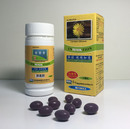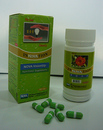新石器晚期 玉琮
新石器晚期 玉琮良渚文化 高15.7公分,寬7公分,深7公分距今約四、五千年前,在長江下游的太湖流域,發展了良渚文化。玉琮正是良渚居民用以祭祀神祇祖先的重要禮器。良渚玉琮的基本造形為略呈上大下小的方柱體,有上下貫穿的大圓孔;外壁以四個轉角線為中心,上下垂直堆疊地雕琢「面紋」。這件深淺交雜的褐色玉琮,是典型的良渚文化晚期玉琮;外壁分為六節,每節以轉角線為中心各琢一小眼面紋,全器共有二十四個面紋。每個面紋以刻有平行線的長橫稜象徵神祖所戴的「羽冠」;以同心雙圈刻繪出眼睛,還刻有代表眼角的短線;象徵鼻子的短橫稜上,則刻繪兩端方轉的單線。因為年代久遠,這些刻紋都已模糊。 Ts’ung Liang-chu Culture, late Neolithic age (ca. 3300-2000 BC)Height: 15.7 cm, width: 7 cm, depth: 7 cmThe Liang-chu Culture developed around the drainage basin of Lake T’ai in the lower reaches of the Yangtze River around 4000 to 5000 years ago, and the jade "ts’ung" was an important ritual implement used by the people of this culture in the worship of their gods and ancestors. "Ts’ung" were basically square cylindrical objects with a hole bored through the center, running from top to bottom. The external surface was composed of carved “mask motifs”, one on top of the other, centered around the four corners of each level. This “ts’ung”, carved from a piece of jade of deep and light earthy hues, is a classic example from the late Liang-chu period. It has six levels, the corners of which are decorated with a carved mask motif with small eyes. Each of the 24 masks has parallel lines representing a feathered headdress worn by an ancestor or god. The eyes are concentric circles with dashes forming the corners of the eyes, and two single lines perpendicular to a short horizontal oval form the nose. Due to the age of this piece, these carved markings are no longer very distinct. 國立故宮博物院national palace museum

相關產品
-

新石器晚期 玉琮
新石器晚期 玉琮高 47.2公分,上端寬 7.7-7.8公分,下端寬6.8公分,孔徑4.2-4.3公分,5850公克這件大玉琮應是在十九世紀入藏清宮的,所以在它的器表沒有乾隆皇帝的題詩,因此保留了它的原貌。它是以深碧綠色泛深淺赭斑的閃玉(Nephrite)琢成。表面還留有最初切璞時的圓弧形凹陷痕。高方柱體,略呈上大下小。中孔由兩端對鑽,接合處有不整齊的台階面。上射口略外撇,下射口較直。以四個方轉角為小眼紋的中心,自上而下,雕琢十七節小眼面紋,所以在這件玉琮上,共有六十八個小眼面紋。到了良渚文化晚期時,已少見如上一件良渚文化時期玉琮上所雕的小眼、大眼面紋的組合花紋。而常以多層小眼面紋取代。且有時在這類高琮的上射口處,以極輕的、斷續的細陰線,刻出神秘的符號。如這件玉琮的上射口上,就有這樣的符號。其中之一為每條邊線都略呈內凹的菱形;相對的另一邊,則刻一上大下小的立柱,下方接著五個小圓圈。其內涵或與當時人們信奉的「神鳥」有關。 Ts’ung Liang-chu Culture, late Neolithic age (ca. 3300-2000 BC)Height: 47.2 cm, upper width: 7.7-7.8 cm, lower width: 6.8 cm, hole diameter: 4.2-4.3 cm, weight: 5850 gThis large jade ts’ung tube probably entered the Ch’ing court in the 19th century, which is why its surface was not adorned with imperial inscriptions of praise by the Ch’ien-lung Emperor (r. 1736-1795) and thereby retains its original appearance. It is carved from a piece of deep green nephrite with light and dark ochre spotting. The surface still reveals the arcing traces of depressions lefty when the jade was first cut. Of a tall, square, columnar form, the top is slightly larger than the bottom. The hole in the center was drilled from both ends, there being a slightly uneven ledge where the two did not match up. The upper hole is slightly flaring, while the wall of the lower is straighter. With patterns of small eyes as the center of the four corners, extending from top to bottom is a total of 17 small-eye masks carved on the piece. By the late Liang-chu Culture, few Liang-chu jade ts’ung like the other one here were being carved with combination patterns of small- and large-eye masks. Sometimes on the mouth area of such tall ts’ung are very faint and broken lines, representing the engravings of some mysterious symbol. The mouth of this jade ts’ung also includes this symbol. Among them is a slight diamond shape depression besides each line. Opposite the sides is an engraving of a standing column with the top larger than the bottom, which continues with five small circles. Their meaning is probably related to the ”spirit bird” beliefs current at the time. 國立故宮博物院national palace museum
-

華諾溶栓寶腸溶膠囊
價值&優勢: 1.納豆激酶的1000倍以上 2.獨特配方及劑型。 3.獨特腸溶膠囊劑型:膠囊密封包裝、品質穩定、不易受潮且不易仿造。The feature of our products are with "real", the "visible" and "functional significance", so leaves other big pharmaceutical biotech companies in Taiwan far behind. Epidemiological studies show strong links between heart disease and stress factors. Such disorders include coronary heart disease, hypertension, atherosclerosis and thrombosis. In fact, many physicians believe that stress, particularly occupational stress, is the most important factor in coronary heart disease and heart attacks. 本產品適用於:中老年人、長時間坐臥族群、長時間工作族群、高度壓力、瞬間激烈運動族群 建議食用量:口服:一天三次,一次1粒;情況特殊者,一天兩次,一次兩粒。 需飯前30分鐘食用。 每4~6週為一食用程,可連服2~3個食用程;也可連續食用至狀況改善或消失。 Usage and dosage: 1 cap TID or 2 cap BID orally . To be taken 30 minutes before meal. A typical course of treatment would be 8~18 weeks 請保持瓶蓋密閉,貯存於陰涼乾燥處,避免陽光直射,並置於孩童伸手不及處 Keep bottle tightly closed, Stock in a cool& dry place and avoid exposure to sunlight 不添加任何無防腐劑、化學色素及人工香料 Preservatives free ★注意事項: 1.懷孕期及哺乳期婦女禁止使用 2.多食無益,每日請勿超過4粒★Restrictions on Use: 1.Pregnant woman and woman in lactation is contraindicated. 2.More taking is without any benefits. 每一 Licap 膠囊含量: Each Licap capsule contains: 蛋白水解複合酶粉末 (效果約為活性Nattokinase效價之800倍以上)Proteolytic Enzymes powder(High Potency: The Potency is more than 800 times of active Nattokinase) 45萬單位 450,000 units 綠茶萃取物Camellia sinensis Extract Powder 15mg CoQ10粉末 CoQ10 powder Extracted from fermented biotechnolgy 10mg L-精胺酸粉末L-arginine powder 45mg 洋蔥鱗莖萃取粉末Onion extract powder 30mg 丹蔘萃取物Salvia Miltiorrhiza Extract Powder 75mg 紅景天萃取物粉末Rhodiola extract powder 30mg 葛根萃取物Puerarin Lobata Root Extract Powder 30mg 五味子萃取物Schisandra chinensis Extract 30mg 當歸萃物取物Chinese Angelica Extract Powder 15mg 維生素EVitamin E 3mg 葡萄糖酸鋅 Zinc gluconate 3mg (其他成分:硬脂酸鎂、二氧化矽、明膠) 營養標示Nutrition labeling 每100公克含量Content per 100 gm 熱 量(Calories) : 356.0 大卡(Kcal) 蛋 白 質(Protein) : 69.9 公克(g) 脂 肪(Fat) : 4.5 公克(g) 飽和脂肪 (Saturated fat) : 0 公克(g) 反式脂肪 (Trans fats) : 0 公克(g) 碳水化合物:(Carbohydrates) : 9.0 公克(g) 鈉(Sodium) : 127.0 毫克(mg) 本產品重金屬含量測定 行政院衛生署公告食品重金屬標準 行政院衛生署藥品、化妝品重金屬標準 美國國家科學研究院食品營養部門, 建議"銅"(copper)每天的適當攝取量如下表: 年齡(Age) 攝取量(ESSADI) 嬰兒 0.4~0.7 (mg) 1-3(歲) 0.7~1.0 (mg) 4-6(歲) 1.0~1.5 (mg) 7-10 (歲) 1.0~2.0 (mg) 11-18(歲) 1.5~2.5 (mg) 成人 1.5~3.0 (mg) ESSADI(estimated safe and adequate daily dietary intake) Copper may have antioxidant activity. 可塑劑/塑化劑 檢測報告 重金屬 檢測報告 授 權 廠 商:華諾醫藥微脂體生技有限公司地 址:高雄市三多三路220號11F之3服 務 電 話:886-7-5514797,886-7-5364260傳 真:886-7 -5215127,886-7-3389032Research & products manufacturers:NOVA PHARMA AND LIPOSOME BIOTECH CO.,LTDAddress :Room3, 11F.,No.220. Sanduo 3 rd Rd., Lingya District, Kaohsiung City 80241, Taiwan(R.O.C)Services telephone: 886-7-5514797,886-7-5364260Fax tel: 886-7 -5215127,886-7-3389032O E M 廠 商:99-704255-00榮 獲 ISO9001:2000國際品質標準榮 獲 HACCP :2002品質管理&食品安全系統標準OEM factory registration Text: 99 - 704255-00Won the ISO9001: 2000 international quality standardWon the HACCP Food Safety & Quality Management System Standard保存期限:如包裝所示Retention period: As shown in the packaging
-

華諾視視如意軟糖顆粒 加強型
價值 & 優勢: 1.首創專為兒童而設計的較佳劑型2.本產品之劑型及配方為台灣研發&製造業的較佳品牌 建議食用量:每日兩次,每次1~2粒。多食無益Suggested use:Two sugar coating Tab Two time daily, more taking is without any benefit. 請保持瓶蓋密閉,貯存於陰涼乾燥處,避免陽光直射,並置於孩童伸手不及處Keep bottle tightly closed, Stock in a cool&dry place and avoid exposure to sunlight 無防腐劑Preservatives free ★注意事項:1.懷孕期及哺乳期婦女禁止使用 2.多食無益,每日請勿超過4粒 ★Restrictions on Use: 1.Pregnant woman and woman in lactation is contraindicated. 2.More taking is without any benefits. 每一粒脆皮軟糖含量:Each sugar coating Tab contains: 金盞花萃取物 Marigold extract powder 15mg 山桑子萃取物 Bilberry extract powder 20mg 紅景天萃取物 Rhodiola extract powder 20mg β-胡蘿蔔素 β-carotene 3mg 葡萄糖酸鋅 Zinc gluconate 3mg 維生素E Vitamin E 3mg (其他成分:砂糖、麥芽糖、D-山梨醇、D-木醣醇、葡萄糖、橘子香料、天然食用香料及色素、檸檬酸、果膠、阿拉伯膠) 營養標示 每份(每一顆粒)1.5公克(g) 本包裝含62份(顆粒) 每份 每日參考值百分比 熱量蛋白質脂肪 飽和脂肪(酸) 反式脂肪(酸)碳水化合物 糖鈉 4.12大卡 0.02公克0公克0公克0公克1.0公克0.95公克0.4毫克 0% 0%0%0%0%0%*0% 可塑劑/塑化劑 檢測報告 OEM 廠商製造廠登記證號:99-701952-01榮 獲ISO9001:2000國際品質標準榮 獲HACCP:2002品質管理&食品安全系統標準OEM factory registration Text : 99-704255-01Won the ISO9001: 2000 international quality standardWon the HACCP : 2002 Food Safety & Quality Management System Standard保存期限:如包裝所示Retention period: As shown in the packaging授 權 廠 商:華諾醫藥微脂體生技有限公司地 址:高雄市三多三路220號11F之3服 務 電 話:886-7-5514797,886-7-5364260傳 真:886-7-5215127,886-7-3389032Research & products manufacturers:NOVA PHARMA AND LIPOSOME BIOTECH CO.,LTDAddress :Room3, 11F.,No.220. Sanduo 3 rd Rd., LingyaDistrict, Kaohsiung City 80241, Taiwan(R.O.C)Services telephone: 886-7-5514797,886-7-5364260Fax tel: 886-7 -5215127,886-7-3389032
-

華諾 加強型光泉膠囊-葉黃素加強型
價值 & 優勢:獨特配方 絕佳原料 特殊劑型 If your mental and physical fatigue lead to further stress forming a viciouscircle. 建議食用量:每日兩次,每次一粒。多食無益Suggested use: One cap two time daily.More taking is without any benefit. 請保持瓶蓋密閉,貯存於陰涼乾燥處,避免陽光直射,並置於孩童伸手不及處 Keep bottle tightly closed, Stock in a cool& dry place and avoid exposure to sunlight 無防腐劑 Preservatives free ★注意事項: 1.懷孕期及哺乳期婦女禁止使用 2.多食無益,每日請勿超過兩粒★Restrictions on Use: 1.Pregnant woman and woman in lactation is contraindicated. 2.More taking is without any benefits. 每一 Licap 膠囊 含量:Each Licap contains : 牛磺酸 Taurine 90mg 金盞花萃取物Marigold extract powder 75mg 山桑子萃取物Bilberry extract powder 75mg 丹蔘萃取物 Salvia Miltiorrhiza extract powder 75mg 紅景天萃取物 Rhodiola extract powder 60mg 松樹皮萃取物 Pine bark extract powder 30mg 綠茶萃取物 Camellia sinensis Extract Powder 30mg 葡萄糖酸鋅 Zinc gluconateβ-胡蘿蔔素 6mg 維生素 Vitamin E 6mg β-胡蘿蔔素 β-carotene 3mg (其他成分:硬脂酸鎂、二氧化矽、明膠、純水、食用黃色四號、食用藍色一號、二氧化鈦) 營養標示 每份(每一膠囊)480毫克(mg) 本包裝含62份(膠囊) 每份 每日參考值百分比 熱量 蛋白質 脂肪 飽和脂肪(酸) 反式脂肪(酸) 碳水化合物 糖 鈉 2.8大卡 0.3公克0.04公克 0公克 0公克 0.3公克 0公克0.24毫克 0%0%0%0%0%0%* 0% 每日參考值:熱量2000大卡、蛋白質60公克、脂肪60公克、 飽和脂肪(酸)18公克、碳水化合物300公克、鈉2400毫克。 *參考值未定 本產品重金屬含量測定 行政院衛生署公告食品重金屬標準 行政院衛生署藥品、化妝品重金屬標準 美國國家科學研究院食品營養部門, 建議"銅"(copper)每天的適當攝取量如下表: 年齡(Age) 攝取量(ESSADI) 嬰兒 0.4~0.7 (mg) 1-3(歲) 0.7~1.0 (mg) 4-6(歲) 1.0~1.5 (mg) 7-10 (歲) 1.0~2.0 (mg) 11-18(歲) 1.5~2.5 (mg) 成人 1.5~3.0 (mg) ESSADI(estimated safe and adequate daily dietary intake) Copper may have antioxidant activity. The impact of stress is measurable in computer terminal workers who show elevated and sustained levels of stress hormones. 可塑劑/塑化劑 檢測報告 重金屬 檢測報告
-

華諾純天然金盞花膠囊 葉黃素加強型
價值 & 優勢:獨特配方 絕佳原料 特殊劑型 建議食用量:每日一次,每次兩粒。多食無益Suggested Use:Two licaps daily . If some case necessary,may take two licaps twice daily. More taking is without any benefit. 請保持瓶蓋密閉,貯存於陰涼乾燥處,避免陽光直射,並置於孩童伸手不及處 Keep bottle tightly closed, Stock in a cool& dry place and avoid exposure to sunlight 無防腐劑、化學色素及人工香料 Preservatives free ★注意事項: 1.懷孕期及哺乳期婦女禁止使用 2.多食無益,每日請勿超過兩粒★Restrictions on Use: 1.Pregnant woman and woman in lactation is contraindicated. 2.More taking is without any benefits. 每一 Licap 膠囊 含量:Each Licap capsule contains: 金盞花萃取物 Marigold extract powder 75mg 丹參萃取物 Salvia Miltiorrhiza extract powder 45mg 紅景天萃取物 Rhodiola extract powder 45mg 山桑子萃取物 Bilberry extract powder 30mg 葡萄糖酸鋅Zinc gluconate 6mg 維生素EVitamin E 6mg β-胡蘿蔔素 β-carotene 3mg (其他成分:明膠、硬脂酸鎂、二氧化矽) 營養標示 每份(每一膠囊)300毫克(mg) 本包裝含62份(膠囊) 每份 每日參考值百分比 熱量 蛋白質 脂肪 飽和脂肪(酸) 反式脂肪(酸) 碳水化合物 糖 鈉 1.4大卡 0.1公克0.02公克 0公克 0公克 0.2公克 0公克0.24毫克 0%0%0%0%0%0%* 0% 本產品重金屬含量測定 行政院衛生署公告食品重金屬標準 行政院衛生署藥品、化妝品重金屬標準 美國國家科學研究院食品營養部門,建議"銅"(copper)每天的適當攝取量如下表: 年齡(Age) 攝取量(ESSADI) 嬰兒 0.4~0.7 (mg) 1-3(歲) 0.7~1.0 (mg) 4-6(歲) 1.0~1.5 (mg) 7-10 (歲) 1.0~2.0 (mg) 11-18(歲) 1.5~2.5 (mg) 成人 1.5~3.0 (mg) ESSADI(estimated safe and adequate daily dietary intake) Copper may have antioxidant activity. To get a good dose of stress which is aggravated by the sedentary position of driving. For those who often drive under such conditions, traffic becomes a daily, repetitive source of stress if not managed well, mainly by a change of attitude. 可塑劑/塑化劑 檢測報告 重金屬 檢測報告 OEM 廠商製造廠登記證號:99-704255-00榮 獲 ISO9001:2000國際品質標準榮 獲 HACCP :2002品質管 理&食品安全系統標準OEM factory registration Text :99-704255-00Won the ISO9001: 2000 international quality standard Won the HACCP : 2002 Food Safety & Quality Management System Standard保存期限:如包裝所示Retention period: As shown in the packaging 授 權 廠 商:華諾醫藥微脂體生技有限公司地 址:高雄市三多三路220號11F之3服 務 電 話:886-7-5514797,886-7-5364260傳 真:886-7 -5215127,886-7-3389032Research & products manufacturers:NOVA PHARMA AND LIPOSOME BIOTECH CO.,LTDAddress :Room3, 11F.,No.220. Sanduo 3 rd Rd., Lingya District, Kaohsiung City 80241, Taiwan(R.O.C)Services telephone: 886-7-5514797,886-7-5364260Fax tel: 886-7 -5215127,886-7-3389032




